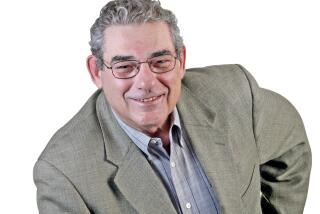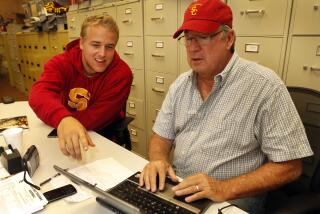David Laventhol dies at 81; publisher during L.A. Times expansion
David Laventhol, an editor and publisher who helped create the innovative Style section of the Washington Post and launch New York Newsday and guided the Los Angeles Times during a period of expansion in the early 1990s, has died. He was 81.
Laventhol, who had in recent years been working on a book about the history of Times-Mirror Corp. despite worsening symptoms of Parkinson’s disease, died Wednesday at his New York home, said former Times executive Steven Isenberg.
Colleagues who worked with Laventhol over decades and on both coasts remembered him as a newspaper man’s publisher and bold visionary in an era when newspapers were financially ascendant and their leaders were household names.
------------
FOR THE RECORD:
David Laventhol: In the obituary of former Times Publisher David Laventhol in the April 9 California section, this quote attributed to John J. Goldman was actually from Steve Isenberg: “Dave’s style did not advertise the man. He was a very shy and gentle and wry person. But to know him well was to know how he had a spine of steel. He was a terrific competitor.”
------------
“For me, Dave belongs in the pantheon of great American newspaper men, as an editor, as a publisher,” said Isenberg, a former executive vice president at The Times under Laventhol. “You’re talking about the people who were there in this moment when these papers cast a long shadow of achievement and aspiration.”
As publisher of The Times from September 1989 until January 1994, Laventhol presided over the expansion of daily coverage in Orange County and the San Fernando Valley and the opening of a Ventura County edition.
Editors who oversaw The Times’ coverage of the first Persian Gulf war and the 1992 Los Angeles riots recalled him as a strong advocate for journalists.
Shelby Coffey III, editor of The Times during the riots, said Laventhol showed his strength in approving funding for five special sections.
“It was also a huge expenditure of newsprint,” Coffey said. “Given that it was a time of recession in Southern California and tight cost controls, it was a big call on the publisher’s part to allow us to do that, and it had a key part in allowing us to get a Pulitzer Prize.”
Coffey recalled Laventhol as a relentless builder, always looking for opportunities to expand — and able to secure funding to do it. The paper’s business side “sometimes complained good-naturedly that it was hard to know if Dave was the hard-fisted business publisher or was the editor in him still too sympathetic to the editorial side,” Coffey said. “There was still an editor inside him.”
Alvin Shuster, longtime foreign editor of The Times, recalled Laventhol as a publisher who took care of his foreign staff.
“As foreign editor I would send word to David we needed a bureau here or a bureau there, and those were the good old days when the answer came back, ‘Good idea,’” Shuster said.
After leaving The Times, Laventhol was editor of the Columbia Journalism Review and served on the Committee to Protect Journalists.
In recent years Laventhol had joined The Times’ retired New York bureau chief John J. Goldman on a project to write a book on Times Mirror and the decline of The Times over the last decade of decreasing newspaper advertising.
“Dave’s style did not advertise the man,” Goldman said. “He was a very shy and gentle and wry person. But to know him well was to know how he had a spine of steel. He was a terrific competitor.”
He stepped down as president and publisher of The Times on Jan. 1, 1994, but remained on the board of directors.
“Laventhol is one of the few left at that level who is really from an editorial background,” newspaper consultant Gerald D. Reilly told the New York Times in December 1993, when Laventhol announced his resignation.
David Abram Laventhol was born July 15, 1933, in Philadelphia. He received his bachelor’s degree from Yale University in 1957 and his master’s from the University of Minnesota in 1960. He began his newspaper career as a reporter at the St. Petersburg (Fla.) Times.
Over a career spanning 50 years, Laventhol became an editor at the St. Petersburg Times, an editor at the now-defunct New York Herald Tribune and the Washington Post, and publisher of Newsday, a Long Island daily newspaper owned by Times Mirror.
Isenberg said Laventhol considered his greatest achievement to be the creation of New York Newsday as an offshoot of Newsday in Long Island.
“It was his idea to create New York Newsday,” Isenberg said, “to slip into a niche above the [New York Daily] News and below the New York Times because he saw the place for a paper that would register with a group that didn’t have an affinity with the other newspapers.”
Brought in by renowned Washington Post Executive Editor Benjamin Bradlee to remake the paper’s Style section, Laventhol created a new platform for distinctive voices and literary journalism, Coffey said.
Though Bradlee created the innovative vehicle, Laventhol deserves credit too, Coffey said.
“Justifiably one might say it was a joint effort. David was the first editor and had a lot to do with the conceptualization. He and Ben could take a joint bow on that.”
“He was a wonderful, unlikely media mogul because he always had that charming set of witty asides that he would half mumble and half speak,” Coffey said. “Only if you were skilled at interpreting the original Laventholese could you get that he was actually brilliant.”
Laventhol is survived by his wife, Esther, and children Sarah Laventhol and Peter Laventhol.
More to Read
Start your day right
Sign up for Essential California for the L.A. Times biggest news, features and recommendations in your inbox six days a week.
You may occasionally receive promotional content from the Los Angeles Times.







